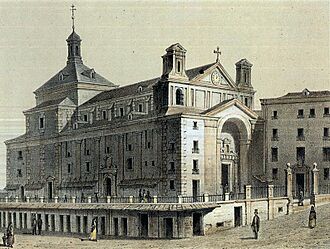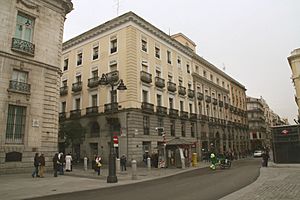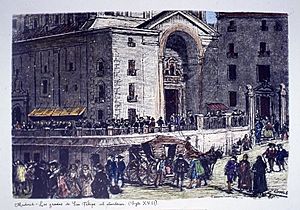Convento de San Felipe el Real facts for kids
The Convent of San Felipe el Real was an old monastery in Madrid, Spain. It was home to Augustinian monks. The convent was built between the 1500s and 1600s. It stood near the famous Puerta del Sol square. A special part of the convent was its steps, known as the "Steps of San Felipe." These steps were a popular meeting spot in the city.
Quick facts for kids Convento de San Felipe el Real |
|
|---|---|

The Convento de San Felipe el Real in a woodcut of 1878.
|
|
| General information | |
| Architectural style | Renaissance |
| Location | Madrid, Spain |
| Coordinates | 40°24′59.09″N 3°42′18.04″W / 40.4164139°N 3.7050111°W |
| Completed | 16th-17th centuries |
| Demolished | 1838 |
| Design and construction | |
| Architect | Luis de Vega, Gaspar de Vega |
Contents
History of the Convent
How the Convent Started
The idea for the convent began in 1539. A man named Francisco Osorio suggested building an Augustinian convent in Madrid. At first, the Archbishop of Toledo, Juan Martínez Silíceo, said no. He thought Madrid already had enough monasteries.
However, many important people wanted the convent built. These included Prince Philip II and Maria of Aragon. Because of their requests, the Archbishop finally agreed.
Building the Convent
The Augustinian convent of San Felipe el Real was officially started in 1547. This was approved by Pope Paul III. The church was named after Saint Philip the Apostle. Prince Philip II was a big fan of this saint.
To build the convent, they used land near the Puerta del Sol. This land was given by the Count of Orgaz. At first, a simple wooden chapel was built in 1545. The main church was designed by architects Luis and Gaspar de Vega.
The building was placed on a raised platform. This was because the ground was uneven. Underneath this platform were small shops called "covachuelas." These shops sold many different things.
Later Years and Demolition
In 1718, the church had a fire. Later, during the French invasion (the Peninsular War), the convent was badly damaged.
Finally, in 1838, the convent was torn down. This happened because the government took over many church properties. The land was then used to make Calle Mayor wider. In its place, the first apartment building in Madrid was built. This building is called the Casa Cordero and was finished around 1845.
The Famous Steps of San Felipe
A Place for News and Gossip
During the 1500s, the convent had strong walls. These walls helped keep the monks' quiet life separate from the busy city. The front of the convent had a large set of steps. These steps were known as the Lonja de San Felipe.
People from Madrid loved to gather on these steps. They would share news, rumors, and secrets. It became known as the "mentidero" of Madrid. This means a place where people "tell tales" or "gossip."
A Busy Meeting Spot
The Steps of San Felipe were also a place where soldiers were recruited. They would sign up to fight in places like the Spanish Netherlands.
One day, too many people gathered on the steps. They were watching someone being taken to prison. The weight of the crowd caused a part of the steps to collapse. This accident led to many people getting hurt.
What Made It Special
The convent had a beautiful cloister (an open courtyard). It was considered one of the best in Madrid. Besides the famous steps, the convent also had the "covachuelas" under its floor. These were small market stalls. People could buy all sorts of goods there, including toys and books.
See also
 In Spanish: Convento de San Felipe el Real para niños
In Spanish: Convento de San Felipe el Real para niños




